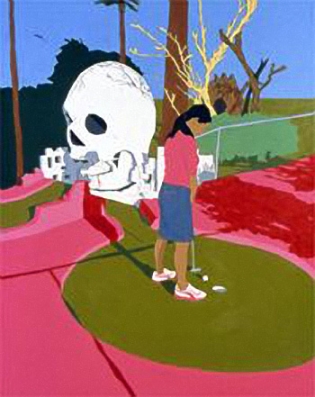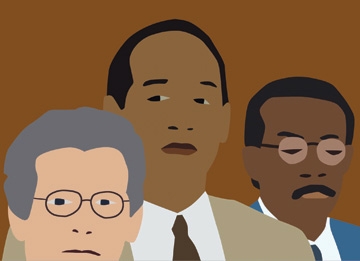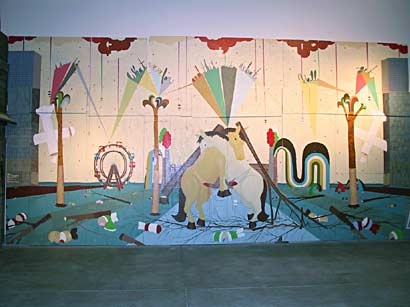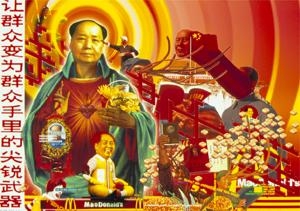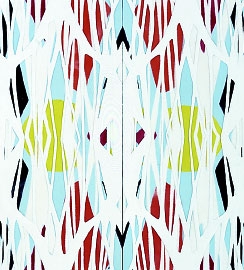Feature: Reviews
Bay Area Now 3
- Yerba Buena Center for the Arts
- San Francisco
- October 26, 2002 - January 12, 2003
Every three years curators at the Yerba Buena Center step up their visits to local studios, searching for the Bay Area’s big picture. “We don’t go looking for art that fits any theme, other than what artists in the Bay Area are doing right now,” says Rene de Guzman, Yerba Buena’s visual arts curator. “We’re empiricists. If trends show up in the exhibition, they appeared in the studios.”
It is the fate of such fishing expeditions to be controversial; the curators may claim they’ve landed heavyweight work, but some viewers will always sniff that their haul is full of whoppers. Whatever one makes of their catch, it feeds an artistic community hungry for respect and serious consideration. Not since the early 1970s, when the San Francisco Museum of Modern Art dumped its yearly survey show, has the Bay Area had a high-profile institution committed to the currents flowing through the garages, lofts, and alleys where Bay Area art is born.
The portals of the show suggest that, at least in the Bay Area, “flowing current” is not primarily a riverine metaphor. On the left, the entrance is framed by Jim Melchert’s Plugging In (2002), a portrait in ceramic pencil on ceramic tile of the plastic electrical cover plate just below the work. Coated with layers of paint from many installations, the plate’s edges are blurred. The paint skin on the socket holes bears a halo of scratches where people plunging plug towards socket missed their mark. Melchert drew each and every scratch large; making a dry comment on our fumbling relationship with electricity and its technologies.
In humorous counterpoint, the curators positioned Christopher Garrett’s Mistakes Can Manifest (2002) as the other guardian piece for the show. The current here – Psychic energy. A bollard-size ball of white paper, wadded up as if it were a rolling compendium of mistakes, sports a chunk of crystal knotted onto a leather string. This tongue-in-cheek nod to mystical healing is a first, lonely reference to higher power; with one other exception, an installation by Kamau Amu Patton that refers to Haitian voudon, the artists in this show gaze down or out, not up.
Perhaps it was this earthbound focus that inspired de Guzman to write that in contrast to Bay Area Now 2, “a gleaming testament to the liberating possibilities of the Internet and technology,” Bay Area Now 3 is about “prosaic day-to-day experiences.” Reading this as I entered the exhibition, I anticipated references to dishwashing or riding the bus. Instead I found a lot of work that was, in one way or another, charged by electricity: elaborate installations with references to media imagery (Jo Jackson, Leah Modigliani, Frank Haines, Desiree Arlette Holman, Kenneth Tin-Kin Hung), video works (Felipe Dulzaides, Kota Ezawa, Jona Frank, Jon Santos), and painting reminiscent of animé, test patterns, or angiograms (Eamon Giron, William Swanson, Sara Thustra, Amy Ellingson, Katherine Sherwood). Bay Area Now 3 is every bit as permeated by media and technology as its boomtime counterpart. The same week I visited the show, I happened to see a rerun of The Simpsons in which a murderous toupee sends roots deep into Homer’s brain, causing him to take after his son, Bart, with an ax. One could say that dark impulses of the Bay Area’s lush technology toupee, which looked so glamorous for a time, energize this show.
The animated analogy would be appropriate. From the candy-colored paintings of minigolf players by Eamon Ore-Giron to the Disneyesque installations of Frank Haines and Desiree Arlette Holman, colors are local, flat, and bright. Shapes are simple, distinct, and graphic. In a show packed with punchy works, the strongest punch is delivered by Kota Ezawa’s The Simpson Verdict (2002), an animation laid over the original news footage from O.J. Simpson’s trial for murder. Ezawa draws the news like Ellsworth Kelly draws plants, distilling the formal essence of each frame. But Ezawa is also refining in the fourth dimension, dropping out the small continuous flutterings of life and condensing the significant movements into precise gestures. O.J.‘s eyes shift as the foreman rises, a juror blinks, a member of Nicole’s family half-rises in despair. The result is mesmerizing.
The news also inspired Mission muralist Sara Thustra, who responds to the American/Al Qaeda conflict with a cautionary mural. Stylized planes stuck into skyscrapers flank a central plaza where two rearing horses collapse into an embrace, their life spilling away from belly wounds despite their agressive posturing. Thustra is self-taught, according to de Guzman, but he is taught. There’s nothing naïve about about this work, which steals from Paolo Uccello, Roger Brown, and Astro Boy to excellent effect. The mural is part of a larger ensemble, Scarecity (2002) created together by Thustra and Carolyn Ryder-Cooley, with an assist from Stormy Knight. A cache of Ryder-Cooley’s drawings is installed in a shack that also provides a smidgen of street context for Thustra’s mural. The mural benefits from the suggestion of alley space. Ryder-Cooley’s drawings do not, the presentation coming off as an overbuilt effort to amplify essentially intimate works.
Web artist Kenneth Tin-Kin Hung appears to be the true naïf in this exhibition, turning in 60x1.com (2002), a “deliberately user-unfriendly Web site that incorporates confounding devices that frustrate the task of navigation.” Kenneth, baby, it’s been done. I refer you to the Web sites of my medical insurer, my e-mail provider, my city government. Hung also gestures toward telematic presence, displaying household objects such as a fan, blender, and rowing machine near the digital projection of his Web site. Buttons on the home page allow Internet visitors to switch the electronic devices in the gallery space on and off, while viewing the results via Webcam. One of the buttons is marked “anthrax sprayer,” in a hint of the sociopolitical satire that is the real meat of the work. Hung doesn’t seem to be aware of his older soulmate, painter Peter Saul, but it’s a pleasure to see the spirit of Saul’s fluorescent satire reincarnated in his Web pages. Hung has a gift for biting, spitting, hissing, political collage. His Bush girls and Maodonald’s pages are worth wading through the rest of the stuff to see.
Another highlight of the exhibition is the corner juxtaposing Jona Frank’s Drill Team/Still Motion Study (2002) and Amy Ellingson’s Circle/Grid Variation (blue, black, white, yellow) (2002), an inspired bit of hanging that lets one see how these two works, which seem to have little in common, are formally alike. Both are highly ordered, structured by repetition. Both draw the viewer into visual depths seen through screens – in Frank’s case, a video screen embedded in a matrix of film stills and in Ellingson’s case deep layers of wax glimpsed through a translucent top layer. Both encase highly constrained gestures in their patterned fields. This echo effect heightens the impact of both works.
The most pleasurable moment I spent in the show was with Multi-purpose (2002), an installation by Jon Santos, who also designed the exhibition’s graphics. The core of the installation is tucked away in the second-floor balcony, where one encounters what appears to be a haphazard heap of monitors and cardboard boxes, looking as if the artist had been interrupted while unpacking his stuff. But something in the casual arrangement commands attention: a carton wraps an irregular area on the ceiling, the shapes of the boxes are suggested in the video imagery trickling across the screens. Santos walks the line between structure and chaos with offhand finesse.
Works by Keith Boadwee, Thomas Chang, Anne Collier, Linda Geary, Mark Gonzalez, Midori Harima, Jo Jackson, Bob Linder, Leah Modigliani, Abner Nolan, Shaun O’Dell, Aaron Plant, Alena Rudolph, Katherine Sherwood, and Allison Shields are also included in the exhibition.
Bay Area Now 3 also includes performing arts and film/video programs. Visit Yerba Buena on the Web for tickets and information or call (415) 978-2700.

